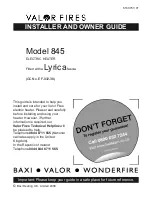
Section
Title
Page
1.
Introduction
1
2.
Technical Data
2
3.
General Requirements
3
4.
Installation
4
5.
Air Distribution System
5
6.
Commissioning & Testing
5
7.
Servicing
6
8.
Connections to Powrmatic
External Controls
7
9.
Fault Finding
8
10.
Short List of Parts
8
Tables
Title
Page
1.
Dimensions
2
2.
Performance Data
2
3.1
Burner Pressures - Natural Gas
Group H - G20
2
3.2
Burner Pressures - Propane - G31
2
4.
Electrical Loadings
3
Figure
Title
Page
1.
Gas Control Schematic NCA-G 100 - 300
6
2a.
Gas Controls Layout NCA-G 100, 150
6
2b.
Gas Controls Layout NCA-G 200, 300
6
3.
Honeywell L4064N
7
Appendix
Title
Page
A
Calculation Of Flue System
Inside
Equivalent Resistance
Back Cover
Appendix A
Calculation Of Flue System Equivalent Resistance
The pressure resistance of the flue system (P
r
) can be calculated from
Pr = 1.5 * [(PFF*H/D+SRF)Q
m
/W
m2
]
Where
Pr
=
Pressure resistance of the flue system in pa
PRF
=
Pipe Friction Factor
H
=
Effective flue height in m
D
=
Internal Diameter of flue in m
SRF
=
Sum of individual resistance factors
Q
m
=
Mean Density of the column of exhaust gas in kg/m
3
W
m
=
Mean exhaust gas velocity in m/s
PRF
Can be calculated from
PRF = 0.118*(0.21147/D
0.4
)
Where
D
=
Internal Diameter of flue in m
SRF
Typical resistance factors for individual components are as follows
Segmented 90° bend
0.5
45° Elbow
0.4
Cowl
1.0
Q
m
Q
m
=
97000/(300*T
m
)
Where
The mean temperature of the column of exhaust gas (T
m
) can be calculated from
T
m
=
288+((Te-TL)/0.2)*(0.18)
Where
T
e
is the exhaust gas temperature in °C
T
L
is the external air temperature in °C
W
m
Wm
=
M/(A*Q
m
)
Where A is the cross sectional area of the flue in m
2
M is the exhaust gas mass flow in kg/s which is as follows for the various units






























